November 30, 2021
© Steven J. Cary
As this long, mild month of November slowly ebbs, I want to touch on three matters: (1) my autumn days of butterfly joy in southeast Arizona, (2) what I missed in New Mexico while I was traveling, and (3) the passing of Dr. Dale A. Zimmerman.
Oh yes, and this: If you have photos of metalmarks from Dona Ana County, New Mexico, or El Paso County, Texas, which have not been posted online, I invite you to please post them to either iNaturalist or BAMONA. If you like Latin, that would be Apodemia mejicanus and Apodemia duryi. If you prefer English, then I seek Mexican, Sonoran, and Dury’s metalmarks. Yes, it is confusing to have three English names for two butterflies, but that may be part of the challenge. So let’s round ’em up (not Palmer’s Metalmark, though). I want to ascertain as definitively as possible how to distinguish these two similar butterflies and your images might help. I will report the results in a future post.
Chiricahuactober
Marcy and I were traveling to San Diego to spend a week housesitting and petsitting for her sister and brother-in-law. What route would take to get there? That’s an easy question. Whenever we can, we steer to the Chiricahua Mountains of southeast Arizona in spring and fall because they offer so much in terms of scenery, weather, hiking, and butterfly opportunities. The New Mexico Bootheel is great, too, with the Coronado National Forest managing much land on both sides of the state line, but on the Arizona side, they provide more developed campgrounds, more and better hiking trails, and more volunteer support for visitors. The Chiricahuas also are 2,000 feet higher and much wetter than our own Peloncillo Mountains, so habitats and butterflies are more varied. As a guilty New Mexican, I want to go to the Peloncillos, but the amenities keep tugging us aging campers over the line. Arizona has had legions of accomplished lepidopterists for decades (for example, see Bailowitz and Brock, 1991, Butterflies of Southeast Arizona), so it’s unlikely that we would “discover” anything surprising, but when I want to see/photograph particular species it is less of a mystery how to accomplish that in southeast Arizona. It’s less of an adventure, too, for better or worse.
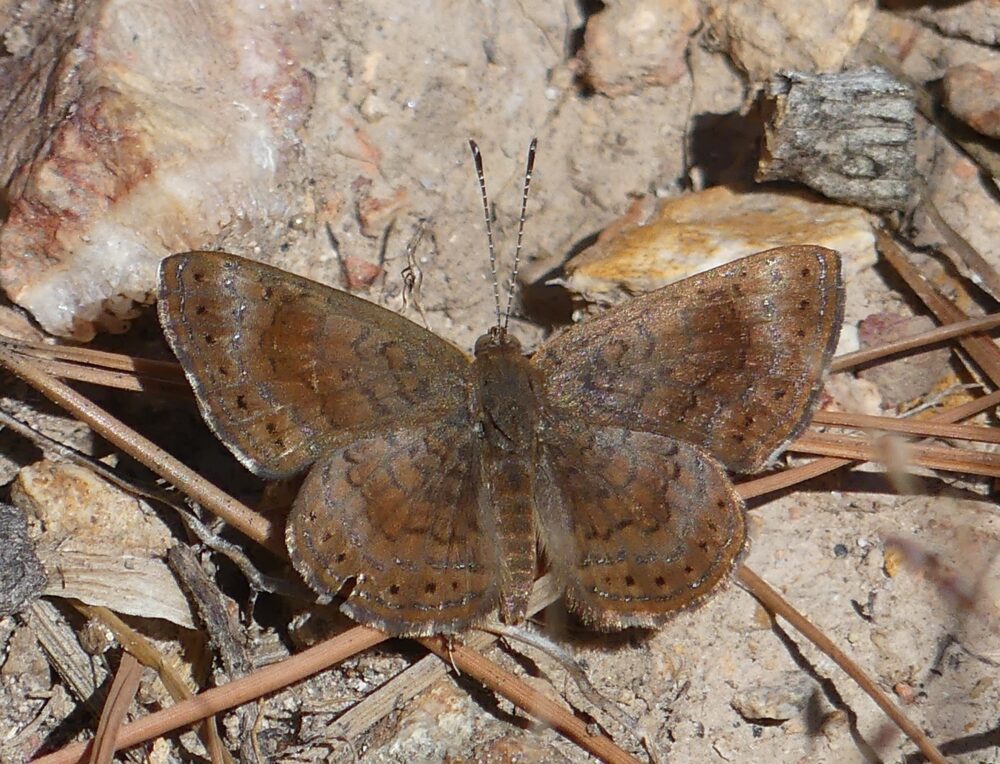
We hitched up our trailer and headed south from Santa Fe on October 16. About seven hours later, we pulled into Ruby’s RV Ranch just north of Rodeo, NM, at about 6:00 PM. On an evening walk-around to stretch cramped legs, we were not surprised to find American Snouts bouncing from one tree canopy to another in crepuscular search of evening roosts. Not gazillions, but a couple per tree. Snouts had quite a legendary summer in terms of numbers and ground covered, including all of the Southwest.
The next morning we drove promptly over to Portal, AZ, found an available campsite at Sunny Flat Campground, and had our boots on the ground by 10:30 AM Arizona time. The South Fork of Cave Creek is accompanied by a very beautiful trail along the main riparian corridor, connecting to side trails that go up much higher. The Big 6 Sulphurs which were so prominent and abundant in southern New Mexico all summer (Sleepy and Tailed Orange, Mexican Yellow, Dogface, and Cloudless Sulphur, plus Dainty Sulphur) continued unabated, perhaps working on their third generation of the warm season. There were Snouts, of course. The highlights for me this day included Arizona Metalmark, Ares Metalmark, and Red-Bordered Brown. These are New Mexico critters, too, but they are easier to access in the Chiricahuas.
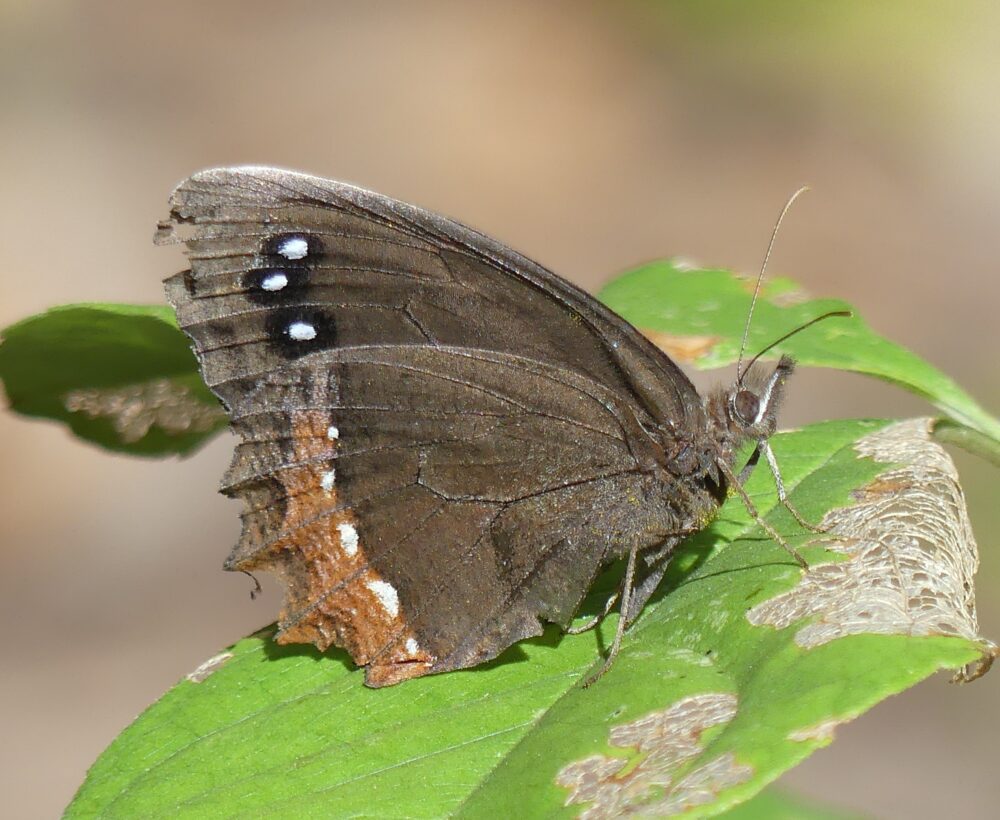
That evening’s full-moon rise augmented an already stunning night sky in which the planets Venus, Jupiter, and Saturn (even Pluto and Neptune if one had a telescope) all were strung out along the ecliptic. For our 3-day, 4-night stay, the weather continued to be delightful with clear skies, daily highs in the 70s, and nighttime lows in the 40s.
The next day we did another hike we liked from back in February: Basin Trail #600, which is less well-traveled and in slightly higher, non-riparian terrain. In New Mexico, I would call it juniper/oak savannah. The trail wound south, crossing several drainages. To remain on a modest grade, trail builders worked upstream (west), crossed the creek bed, then wandered east and around a minor ridge. This was repeated several times with the result that hikers spent about half their time on shady, mesic, north-facing slopes and the other half on sunny, xeric, south-facing slopes, with lots of agaves.
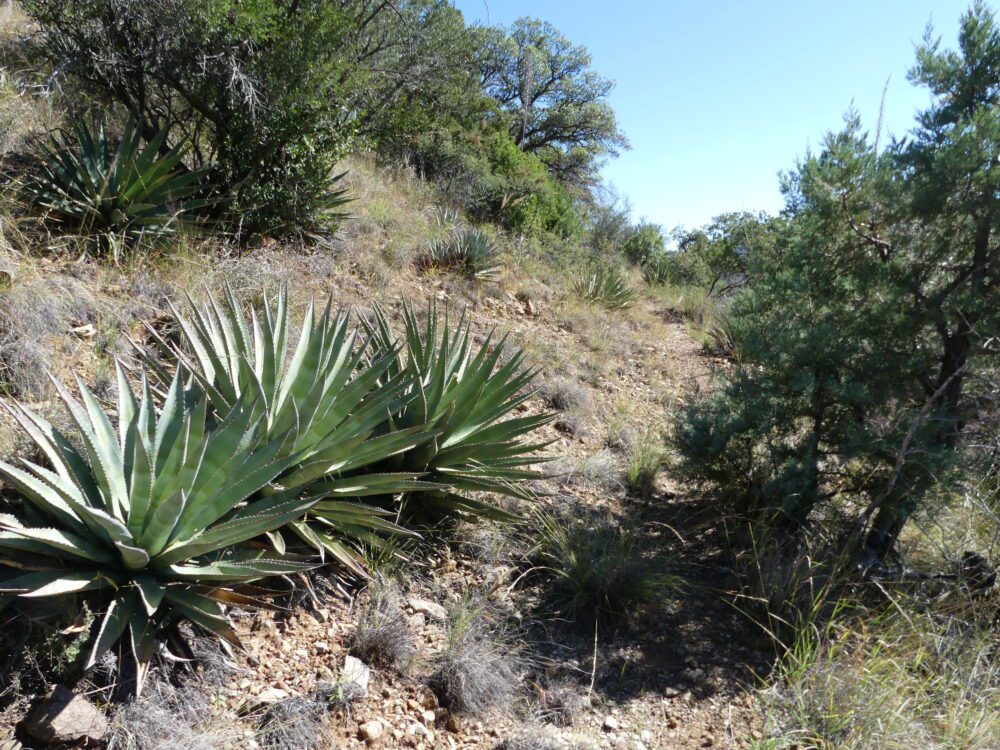
Those agaves (species unknown to me), were hosting a lovely giant-skipper. Being years out of practice on autumn giant skippers and the genus Agathymus as a whole, I was thrilled to see these guys every time we walked a south-facing trail segment. We must have seen 30 of this species. Most were perching and patrolling on or near agaves. At first, I thought maybe they were the widespread Orange Giant-skippers (Agathymus neumoegeni). The coolest option would have been Poling’s Giant-skippers (Agathymus polingi) because they are so scarce in New Mexico, but I remembered their host being the (relatively) tiny Agave schotti, and I was not seeing any of that plant. If it was there, these giant-skippers were ignoring it. I was taking lots of photos as we went, but always undersides, which are very similar among the various species. Then one of my subjects took flight while I was in burst mode. That view, blurry as it was, made it clear this was Arizona Giant-Skipper (Agathymas aryxna). I recall on several occasions in the past, watching that species clatter noisily around damp spots in the road going up Clanton Draw and over the Peloncillos in the New Mexico Bootheel. Fond memories!

Arizona Giant-Skipper (Agathymus aryxna) Basin Trail #600, Chiricahua Mtns., Cochise Co., AZ; October 18, 2021. (Photo by Steve Cary) 
Arizona Giant-Skipper (Agathymus aryxna) Basin Trail #600, Chiricahua Mtns., Cochise Co., AZ; October 18, 2021. (Photo by Steve Cary)
The next day we aimed for my principal target species: Mexican Pine White. I wrote about seeing this species last year (2020) in the Huachuca Mountains, the next major range to the west. I was able to get good shots of the orange female, but the white males eluded me then. So here I was a year later hoping again to photograph males. I thought I knew where to go and Matt Brown kindly affirmed my choices: Rustler Park and Barfoot Park, at 8,000′ elevation up in the pines, logically. The drive up from our camp was spectacular and our morning hike around the Rustler Park area produced some stunning views of golden aspen doing its work to revegetate a mountain that burned about a decade ago. Who says you have to go north to see displays of autumn color?

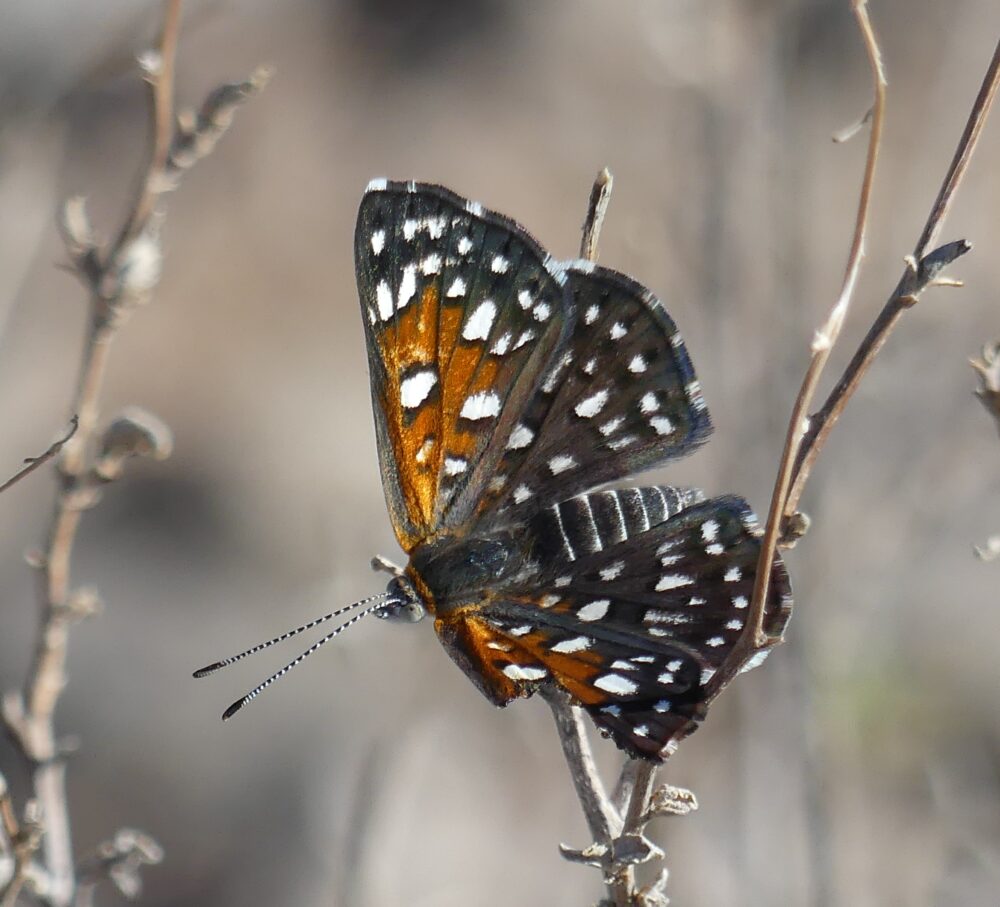
There were plenty of piney areas, too, but we were completely skunked on this day. We looked high in the pines for males, we scattered pieces of orange flagging tape on the ground to lure males down to investigate possible females, but nothing worked. Not a single Mexican Pine White of either gender was seen. We did see a West Coast Lady, but it was not the same thing. I guess we’ll have to come back again next year to try again! ;^)
The next day we broke camp and headed a few hours west to Organ Pipe Cactus National Monument. Along the way we watched as Snout Butterflies flew up and over our windshield at a rate of about 10/hour; not hoards of them, mind you, but the numbers add up over the region as a whole, of course. Sadly, not all cleared our truck, safely. Organ Pipe is a place we have visited before and enjoyed when the weather was good. This time it proved to be hot — not summer hot, but we were not mentally prepared for 90° F in mid-October. I had no specific butterfly objectives there, but we tried a morning hike the next day and, setting aside the Snouts, Dainty Sulphurs, and Painted Ladies, I was pleased to capture the local version of Mormon Metalmark, which I thought looked a lot like what we have in the Farmington area.
What New Mexico Did During My Autumn Vacation
The rest of our trip transpired as well as it could have, except that I was routinely peppered by emails about what I was missing in New Mexico. For example, Northern New Mexico was not going quickly into winter. Rozelle Wright’s Red Admiral, below, showed that various adult hibernators would remain available for viewing for a while longer.
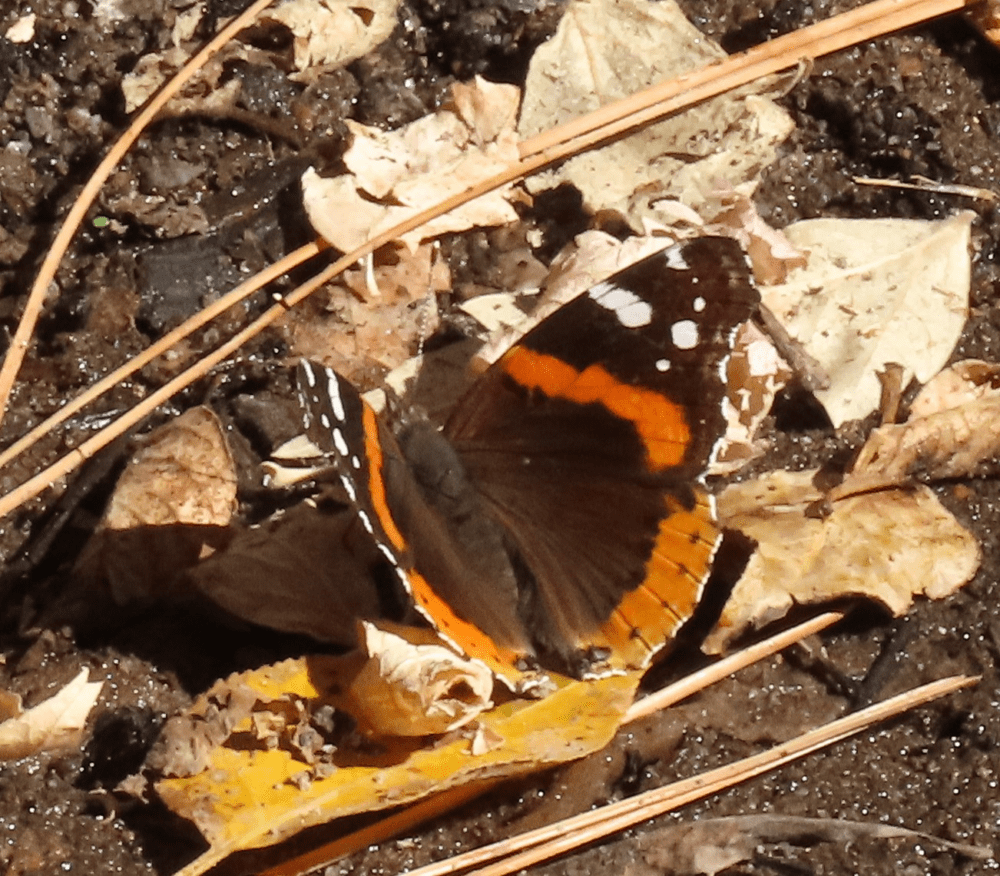
American Snouts were still trying to nose their way north as late as October 25 at Sugarite Canyon State Park, per Kelly Ricks, and October 29 in Santa Fe, per Rene Laubach. Colorado, here they come!
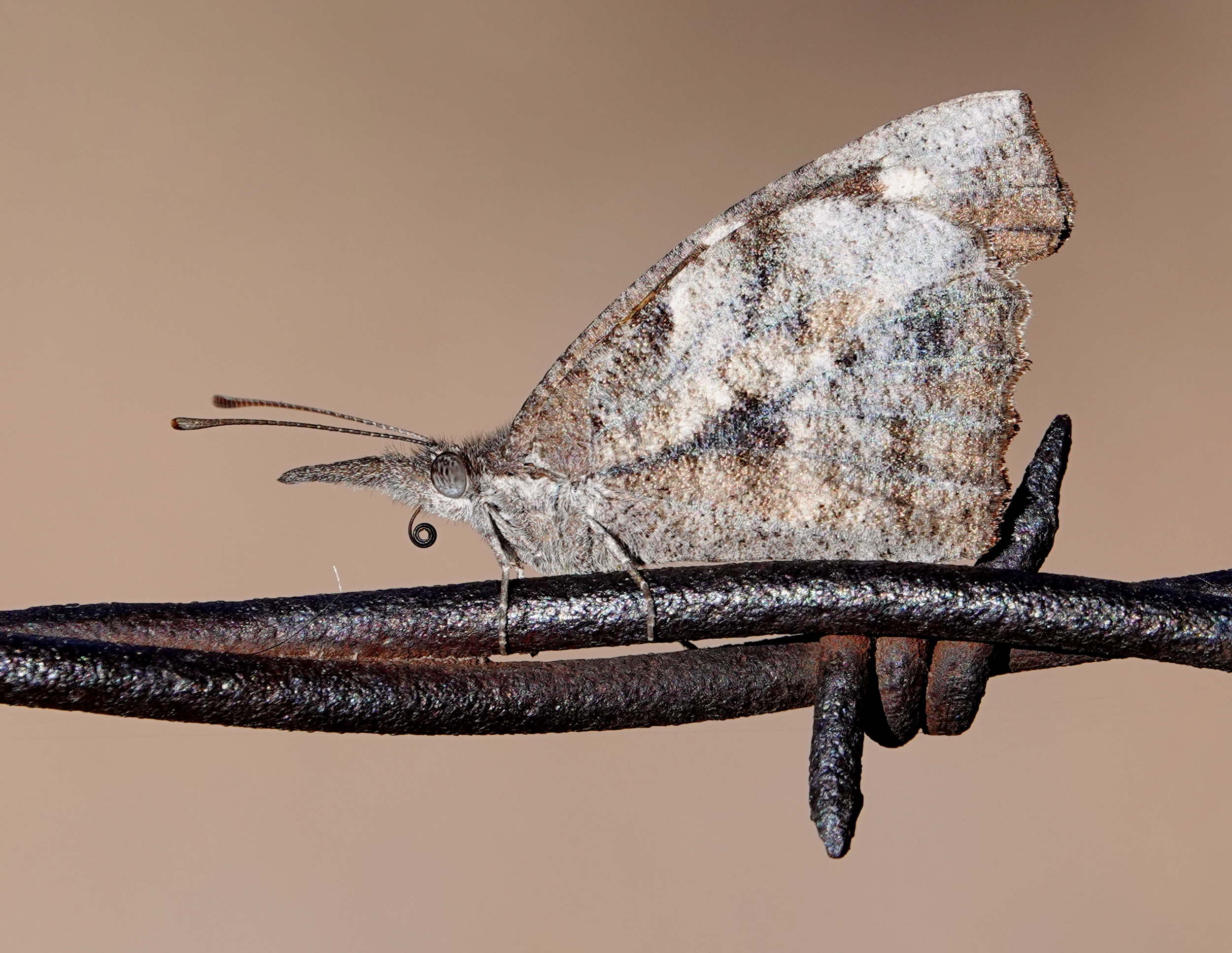
Then there was a barrage of amazing, late-season strays farther south. For example, Joshua CdeBaca saw this on iNaturalist and directed me to it. This is the third sighting ever in New Mexico for Ruddy Daggerwing.
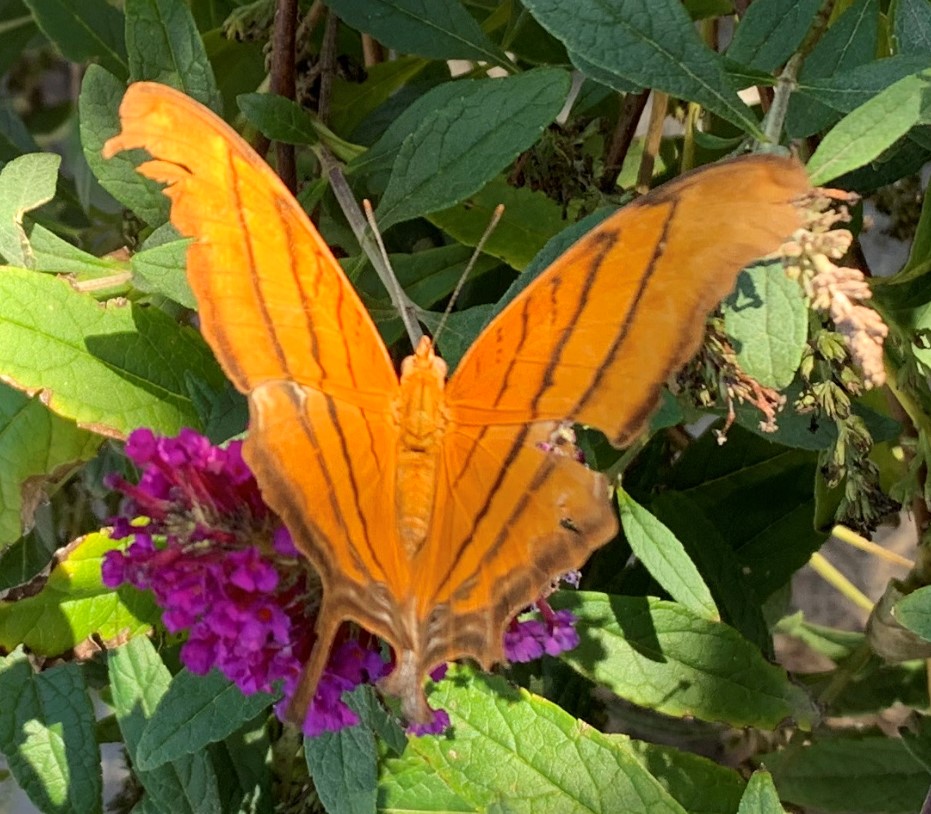
The very next day, CJ Goin was patrolling the Fabian Garcia Gardens, a flowery, well-watered place that became his favorite, late autumn butterfly haunt in Las Cruces. Strays are simply looking for some nectar and on November 2 he photographed this creature below. This was the second sighting ever for New Mexico and the first photograph.
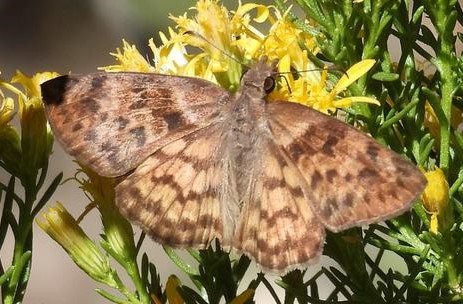
Then the sulphurs went on another — perhaps their final — rampage of the year in the Las Cruces area. Between the two of them, Rob Wu and CJ Goin photographed some real rarities including Lyside Sulphur, another Mimosa Yellow, a Large Orange Sulphur (below), and then a Yellow Angled-Sulphurs in the first-ever photograph for New Mexico. Some of these very fresh individuals this late in the year suggest there was local, in-state breeding this recent summer.

Large Orange Sulphur (Phoebis agarithe) Fabian Garcia Gardens, Las Cruces, Dona Ana Co., NM November 2, 2021. (Photo by CJ Goin) 
Yellow Angled-Sulphur (Anteos maerula) Texas Canyon, Organ Mtns., Dona Ana Co., NM, November 3, 2021. (Photo by Rob Wu)
Will the 2021 butterfly season never end?
An Unbound Mind: Dr. Dale A. Zimmerman
The topic of extended autumns brings me to a final piece of sad news. Dr. Dale A. Zimmerman, of Silver City, NM, gently passed away on November 10, 2021, aged 93 full years. Over several decades and with enthusiastic support from his wife, Marian, Dale made huge contributions to ornithology, entomology, and botany through his scientific endeavors and his exquisite paintings.
Dr. Zimmerman’s official obituary emphasizes his scientific contributions in the field of ornithology, as it should. He earned his Ph.D. in botany and had serious entomological interests as well, but he made his greatest, planetwide impact in the avian world, apparently studying birds on all continents. Career highlights include The Birds of New Guinea (Princeton University Press, 1986), for which he was a co-author and painted 44 plates. That same year he was senior author for Birds of Kenya and Northern Tanzania. He completed and published Birds of Kenya in 1996. Dr. Zimmerman was the primary illustrator of his own books and his paintings have appeared in other works including the 1983 three-volume Audubon Field Guide to North American Birds. Dale was a Fellow of the American Ornithologists Union and he received the prestigious Ludlow Griscom Award from the American Birding Association for his contributions to ornithology.
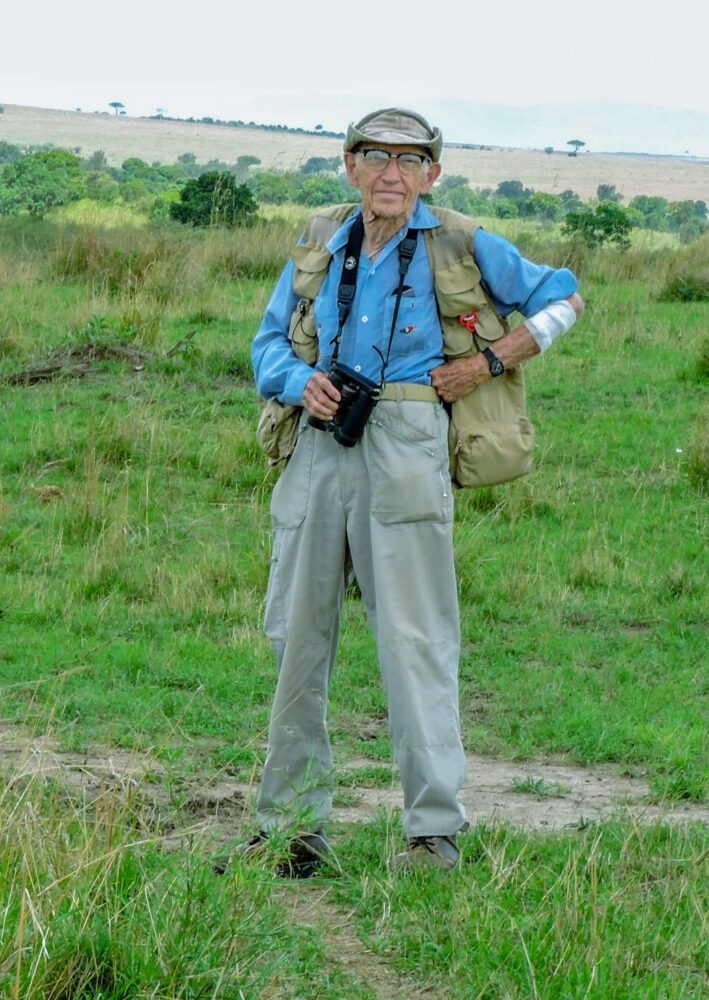
As a force in the world of birds, Dr. Zimmerman was as local as he was international. He published numerous scientific papers in scholarly journals, many relating to New Mexico ornithology. He regularly furnished drawings for the New Mexico Ornithological Society to use on T-shirts and other items. In recognition, he was awarded the F.M. Bailey Lifetime Achievement Award from the New Mexico Ornithological Society. In 2003, the herbarium at Western New Mexico University (he was on the faculty for 31 years) was officially named the Dale A. Zimmerman Herbarium.
In his free time along the way, Dr. Z was a serious collector, rearer, and photographer of butterflies and moths around the world, but especially in southwestern New Mexico. When it came to Lepidoptera publications, he played a largely supporting role, for example in “A checklist of the butterflies of Grant County, New Mexico, and vicinity” (C. D. Ferris 1976, plus supplements in 1977, 1978). Dale’s own Lepidoptera publications also were local, including: “An inventory of the butterfly species on the Gila National Forest, southwestern New Mexico” (2001) and a popular fold-out pocket guide: “Conspicuous Butterflies of the Gila National Forest,” co-authored with Cynthia Hunter.
Dr. Zimmerman’s writing style was simultaneously precise and scientific, yet captivatingly personal. In his 2015 Turaco Country: Reminiscences of East African Birding, he generously offered a chapter entitled Butterfly Digression, from which I share the following paragraph (pp. 663-664): “With so many of Kakamega’s birds shy and retiring, butterflies were the forest’s most visually impressive residents. Daily, as the mercury climbed and bird activity waned, they navigated the air of every forest stratum. Powerful Charaxes sped down the trails and also cruised the canopy. Bright swallowtails and varied nymphalids congregated at puddles and settled on sun-dappled vegetation along every trail. Stunning big Salamis sailed by at intervals, flashing like heliographs, wherever sunbeams penetrated. Even in the deepest shade, I could marvel over big satyrs, strange Euphaedra, and Lilac Beauties; and smaller butterflies abounded. Species diversity and variety of form, pattern, and color were awesome. Every day for weeks, that first summer, unfamiliar species came my way.” I so envy his effortless command of the intricacies and capabilities of the English language.
Dale’s photography skills were no less formidable. At a time when insect macrophotography required a much more intensive effort than it does today, he did what was necessary to excel at it, whether technically or physically in the field. PEEC’s Butterflies of New Mexico displays one of his most prized butterfly photos, the unusual Papilio polyxenes coloro. This brightly colored spring form of the Black Swallowtail occurs irregularly in our far Southwest. On an outing to New Mexico’s remotest southwestern corner, he found it and captured this perfect image (below) on film.
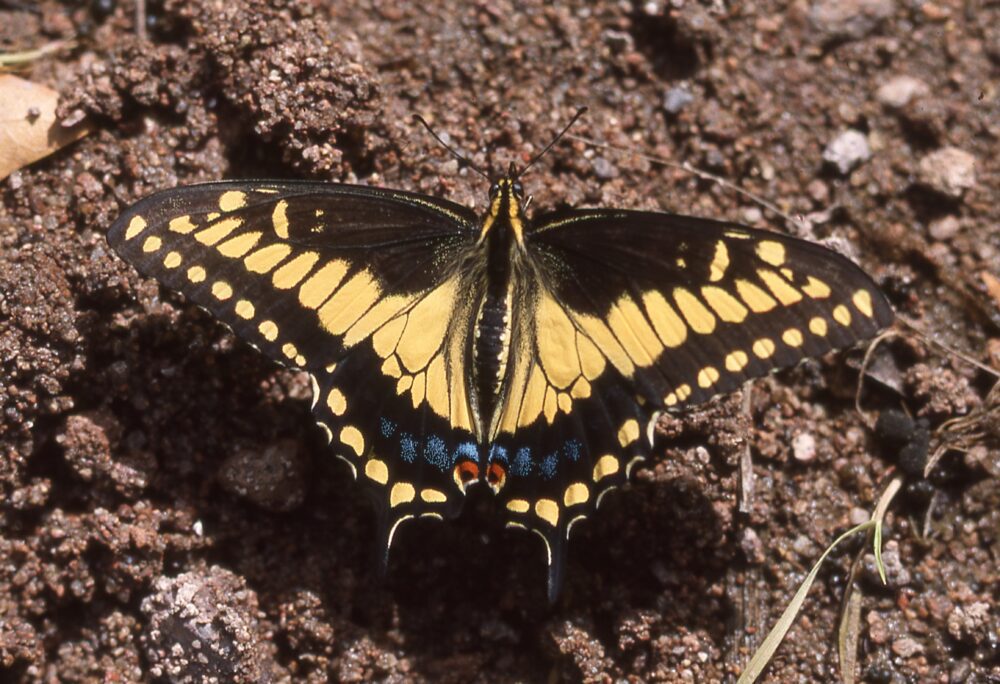

Dr. Zimmerman’s departure is a profound loss, but he left a profound legacy. His bird, insect, and plant collections, not to mention his magnificent paintings, represent a brilliant scientific and artistic legacy. In his seemingly limitless mind and life, he could never cease contributing to the store of human knowledge. On a personal level, Dale was always open and generous to me, sharing his home, his knowledge, stories, and his collections of butterflies and slides without hesitation. Long will he be missed and remembered.
An exhibition of Dr. Zimmerman’s paintings and a memorial will be held in the spring of 2022 in Silver City and will be announced in the local press. Memorial donations can be made to the Southwestern New Mexico Audubon Society. Checks can be sent to SWNM Audubon Society, PO Box 1473, Silver City, NM 88062.
My sincere gratitude goes to Carol Ann Fugagli, who graciously shepherded Dale through his final years and days and contributed to this tribute.
Thank you all for your attention. Best wishes for the holidays and the wet winter to come (fingers crossed).

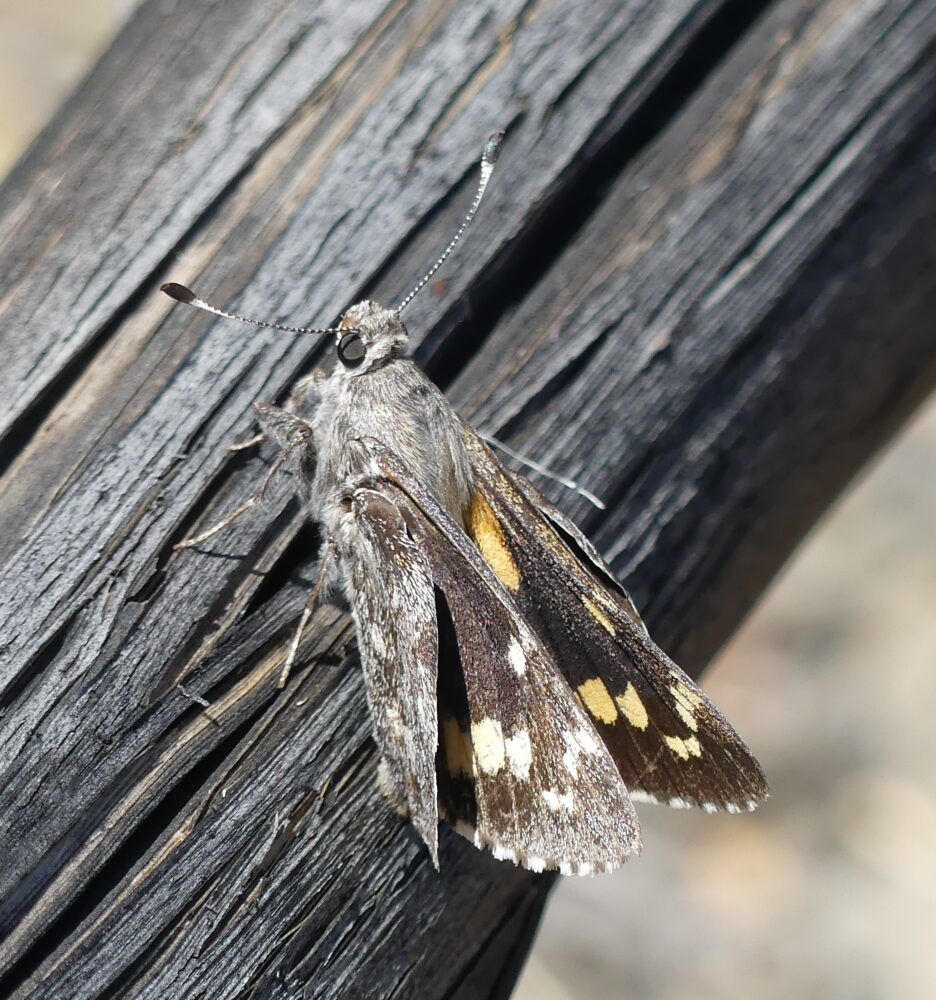
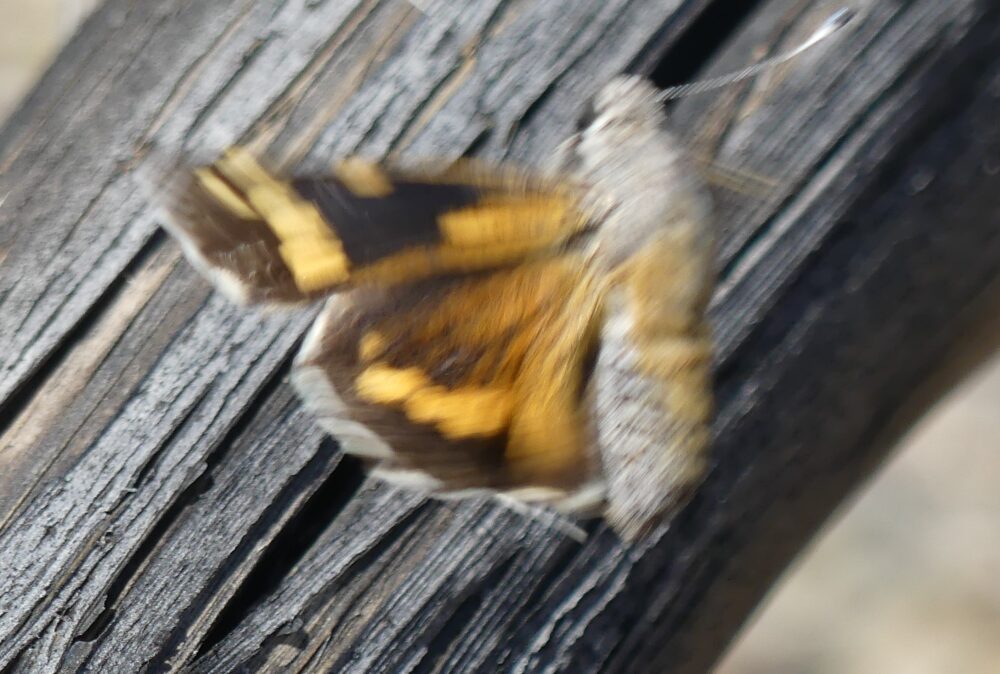
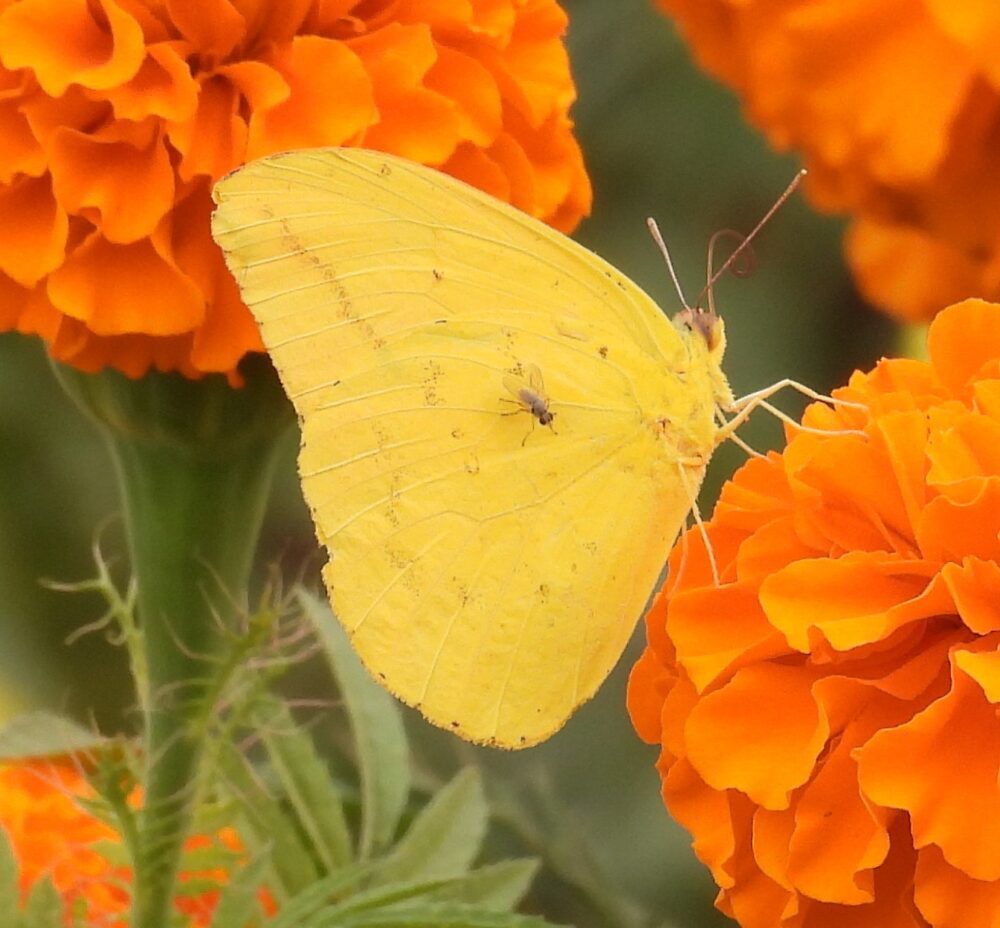
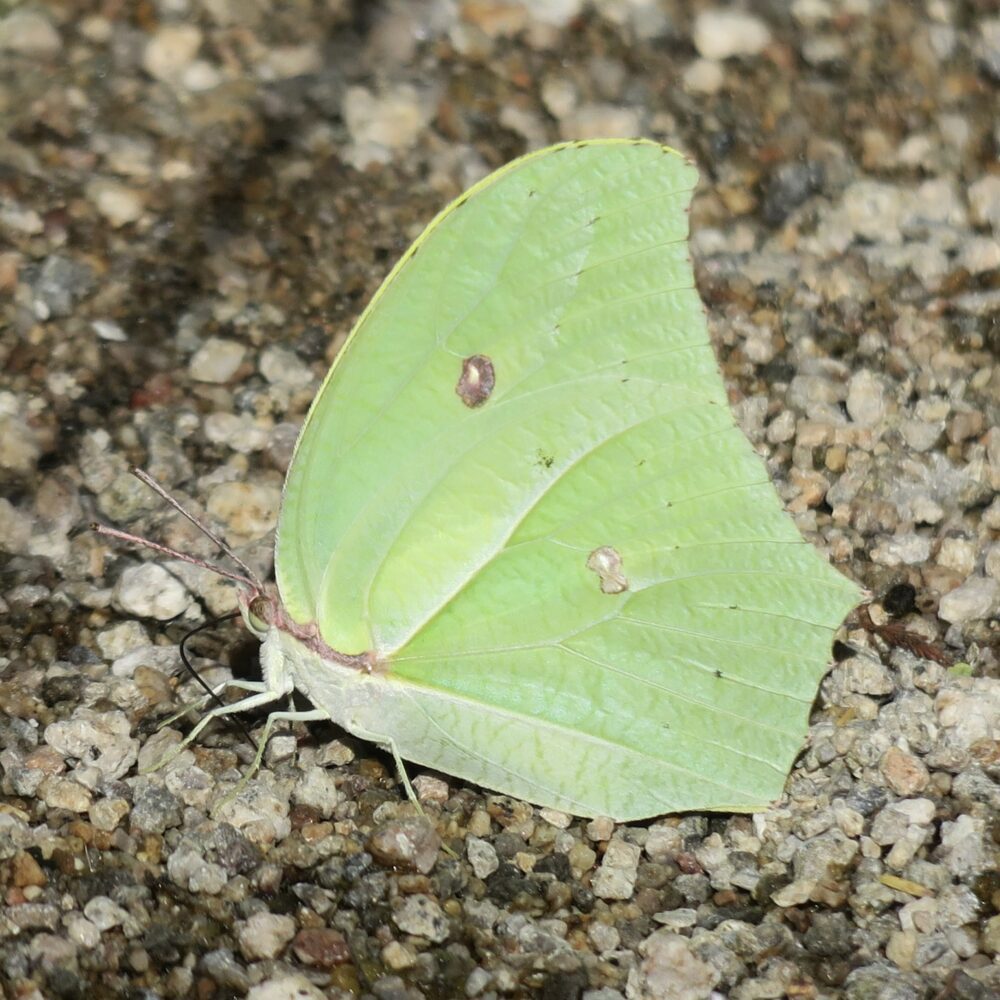
Steve, I would like to make a small correction. I saw the Brown-banded skipper at the Dripping Springs Visitor Center, not the Fabian Garcia Garden.
thanks, CJ. I corrected the error.
Lovely post. I especially liked the idea of decoying butterflies down out of the tall trees
you must have some of the hunter in you :^)
thanks for the love.
Another well written and informative article: thanks, Steve. But it was the news of Dale Zimmerman’s passing that drew my attention, especially in that I’d heard nothing from our ornithological “community”. He was a lovely man whose contribution to our knowledge of the world’s biota, and that of New Mexico in particular placed him on a level above most. Thanks again.
thanks, Lawry. now that you mention it, I haven’t heard much from them either. maybe because it was so long ago . . . ? or I am simply not in their communications.
Hello Steve, What an informative, comprehensive article about your trip. You remarks, descriptions, and photos were so exciting. All the best to you.
Sonya, thankyou so much! I always love to hear from you and I am pleased you enjoyed the read. enjoy your holidays.
Thank you, Steve, for your tribute to Dale, whose formidable skill and knowledge were equaled by his graciousness and quick humor. (And thanks, too, for writing your blog!)
Narca, how great to hear from you. Grace and humor were absolutely part of Dale’s aura. I’m pleased to be back in contact with you and will add you to my blog email list. Best wishes for the holidays!
Steve, I grew up in Silver City, and Dr. Z as we knew him, lived up the block and around the corner from us. He was a great guy to talk to about birds, and we all knew he traveled the world looking at birds. His yard was a haven for all sorts of birds and insects, fenced off so the deer didn’t ravage the yard. He put the fear of god in any kid who rode by on a bicycle with BB gun in hand! I didn’t appreciate his knowledge or dedication at the time, I was in grade school then, but he was very instructive if you were interested. He was not the only unsung knowledgeable person at Western that we knew thru our childhood friends and my father’s acquaintances. Sad to hear of his passing, but it’s the fate of man.